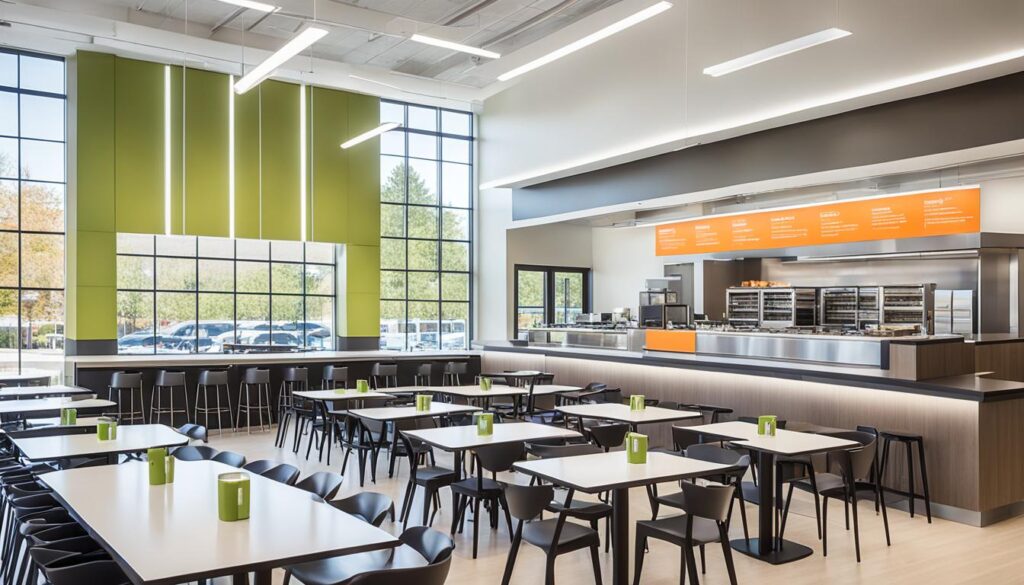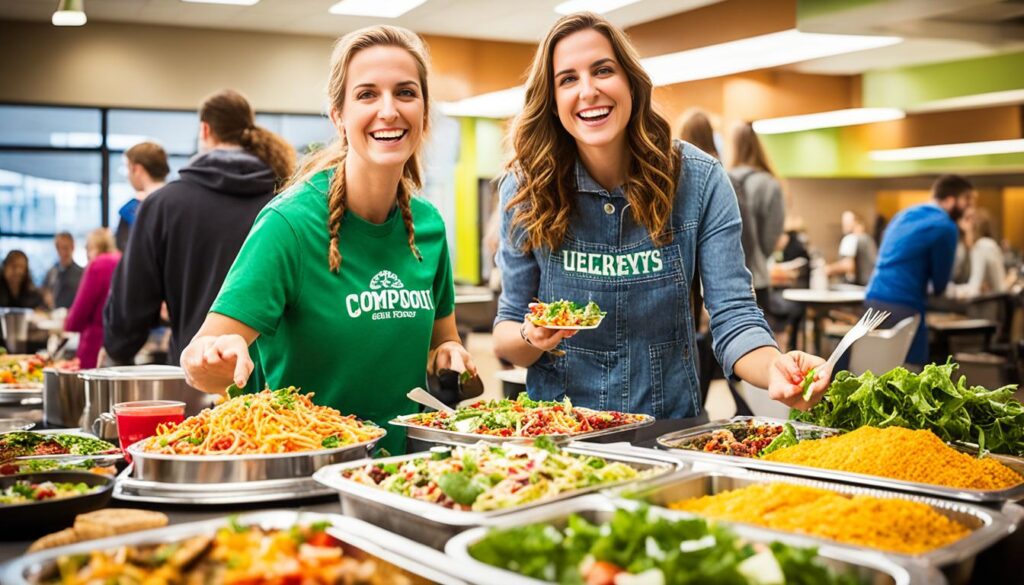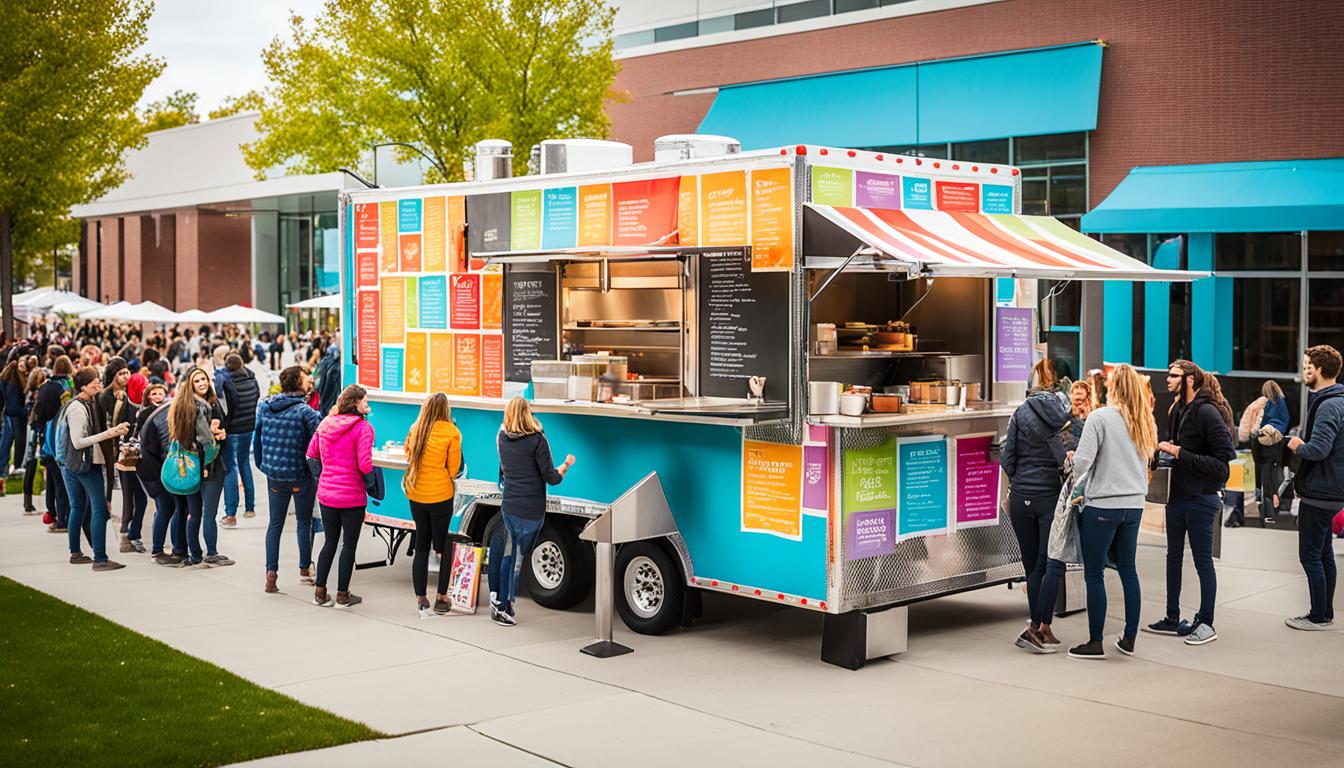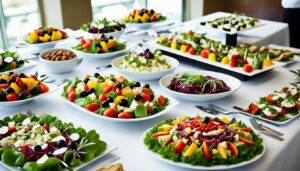Did you know 92% of college students pick their university based on the food options? This fact shows how important university catering is. Today, campus food goes way beyond old cafeteria meals. It offers many tasty and healthy choices for everyone.
Now, university catering is more than just food. It’s a full culinary experience that combines ease with quality. With gourmet meal plans and special catering for events, it’s like eating at a restaurant. This helps build community and meets the needs of today’s students.
At Touro University California, dining is more than just eating. They have a kosher kitchen led by Rabbi Aharon Simkin. It offers chef-made kosher lunches with vegetarian choices at places like Touro Kafe and Touro Bistro1. This shows how university catering meets the needs of all students.
Today’s campus dining has many options. At the University of Oklahoma, students have several places to eat at different times. Acre Provisions is open from 8 am to 10 pm on weekdays, and Baja Fresh Express from 10 am to 6 pm every day2. These hours help students eat well, even with their busy lives.
Key Takeaways
- Campus dining is a big part of choosing a university
- Modern university catering offers many tasty, high-quality options
- It meets the needs of students with special diets
- Flexible dining hours fit students’ busy lives
- Campus dining helps build community and improves student life
The Evolution of Campus Dining Services
Campus dining has changed a lot over the years. No more bland cafeteria food and few choices. Now, dining halls offer a wide range of flavors and options for different diets.
From Cafeterias to Culinary Experiences
Today, university dining halls are lively food spots. For instance, Cyclone Dining Hall at Centenary University has 12 different places to eat. They serve food all day and late at night3. This means students can find fresh, tasty food whenever they’re hungry.
Meeting Diverse Student Needs
Universities now focus on meeting different dietary needs. With more students needing allergen-free food, dining services are changing4. Many schools offer meal plans for specific diets, making sure everyone can eat safely and enjoy their meals.
Adapting to Modern Dietary Trends
Campus dining is getting more eco-friendly and health-focused. There’s been a big jump in using plant-based foods in dining options4. Schools are also starting programs to reduce food waste and compost, helping the planet4.
The way campus dining has changed shows how student needs and lifestyles are evolving. With flexible meal plans, many food choices, and a focus on dietary needs, dining services are making meals that are good for the body and mind.
University Catering: More Than Just Meals
University catering services do more than just feed students. They offer a wide range of options for different campus events. UM Catering, for example, caters to events like weddings, college reunions, and fundraisers across the Missoula valley5.
At catered events, there are many menu choices. Some caterers have Classic, Signature, and Premium entrées for various tastes and budgets. You might find dishes like breaded chicken breast or Boursin cheese-stuffed chicken breast6.
Planning is key for a successful catered event. For events with over 100 guests, Campus Catering needs a 3-week lead time. Smaller events need 2 weeks to prepare. Last-minute changes or late orders might cost extra7.
Many university caterers focus on being eco-friendly. UM Catering uses thousands of pounds of local produce in their meals5. This makes their food delivery services better in quality and freshness.
“Our goal is to provide exceptional dining experiences with creative menus and friendly, professional service tailored to each occasion.”
University catering also helps students. Many services hire student waitstaff, offering flexible jobs and leadership roles. These jobs help students improve their customer service skills and learn about the catering industry5.
Creating a Restaurant-Like Atmosphere on Campus
Modern university dining halls are becoming lively social spots. They’re where students meet, eat, study, and hang out with friends. The goal is to make these places welcoming to everyone, making students feel right at home8.
Innovative Servery Design
Campus food menus now offer a wide range of global flavors. They serve special meals for Passover, Ramadan, and other cultural events. This variety makes dining more exciting and caters to different tastes9.

The design of these spaces combines front and back-of-house areas. This creates a seamless, open feel. At James Madison University, the bakery near the entrance fills the air with fresh bread smells and offers homemade ice cream8.
Food Station Branding
Now, dining halls feature specialty cooking stations. You can find wok stations, sushi platforms, tandoori ovens, and Brazilian barbecues. These stations offer a variety of tastes and cater to different dietary needs, including halal, vegan, and allergy-friendly options98.
On-Trend Menuing
Campus food menus are getting healthier and more sustainable. Many follow the Menus of Change program. This program aims to increase produce and whole grains while reducing animal protein9.
Students like seeing their meals made fresh. The move to open, self-serve stations lets you cook your own food and pick your ingredients. It supports personal taste and sustainable efforts like “farm to table” programs8.
“We want to create a dining space that feels as comfortable as being in one’s mom’s kitchen,” says Lenny Condenzio, a dining design expert.
Customized Dining Programs for Higher Education
Universities are now offering special Campus Dining Services to fit their students’ needs. These programs offer more than just cafeteria food. They have diverse and flexible Student Meal Plans for different diets and schedules10.
Working together, schools and catering companies have come up with new ideas. Some universities have websites and recipe databases where students can rate meals and give feedback to chefs10. This way, dining options can change to match what students like.
- Branded uniforms for staff
- Specialized menus reflecting local cuisine
- Sustainability initiatives
- Health and wellness-focused options
These special dining programs have really worked well. At Warner University, switching to a customized dining program was a big hit. Students loved the food, the prices, and the dining experience11.
But it’s not just about the food. Studies show that eating with friends makes students feel like they belong on campus11. By making dining spaces welcoming and hosting fun food events, schools can build a stronger community among students.
“Delicious food is a way to attract top talent, increase retention, and enhance organizational culture.”
With the right dining program, universities can make their Campus Dining Services a big part of student happiness and staying in school. By offering flexible Meal Plans and focusing on quality, variety, and student feedback, schools can make dining a great experience for both body and mind.
Technology-Driven Solutions in Campus Dining
Campus dining has seen a big change thanks to technology. Today, college students want food delivery and catering menus that use tech. Universities are answering this call with new solutions that make dining better.
Mobile Ordering Systems
Mobile apps have changed how students order food. Now, you can look at the menu, pick what you want, and set a pickup time from your phone. This makes waiting for food shorter and eating out better12.
Advanced Point-of-Sale Technologies
Modern cafeterias use advanced point-of-sale systems. These systems make buying food faster and help learn what students like. This info helps improve the menu and food delivery12.
Management and Accounting Software
Behind the scenes, powerful software helps with inventory, cost tracking, and making things run smoothly. This tech makes sure food gets delivered fast and keeps the menu diverse. It also helps with sustainability by cutting down on waste and using resources wisely1213.
These tech solutions have made campus dining better. Students at places like Park University and Maryville University get better food services thanks to new catering companies13. The use of technology, focus on quality, and care for the planet are starting a new chapter in university dining.
Sustainability and Responsible Operations in University Catering
University catering is now focusing on being more sustainable and responsible. Over the last five years, there’s been a big increase in using local ingredients14. This helps local economies and cuts down on carbon emissions from food transport.
Food safety is also a big deal in university dining. Many schools are trying new ways to be both sustainable and safe. For example, some work with local farms for fresh produce. This ensures quality and cuts down on food miles15.
Reducing waste is another big goal. Tray-less dining has been a big win, saving almost 500 gallons of water per person a year and cutting food waste by 25-30%15. Schools are also getting creative, like turning waste vegetable oil into biodiesel and soap products15.
Food trends are changing too. Campuses are adding more seafood, like salmon and tuna in poké bowls. They’re also cutting down on red meat and adding more vegetarian choices. Some schools even have burgers with 75% beef and 25% mushrooms, and plant-based options like the Impossible Burger16.
Technology is key in these efforts. Tools like LeanPath track and cut food waste, and CBORD Fusion offers custom food and nutrition solutions for schools16. These tools help university dining be more sustainable, safe, and make students happy.
Nutrition and Wellness: Priorities in Campus Dining
Campus dining is changing to fit what students need and like. Schools know how important it is to offer balanced meals and food options for different diets. A study found that only 25% of students think their college has good food choices in the dining halls17.
Balanced Menu Planning
Colleges try to serve a variety of healthy meals. About 40% of students want to see fewer ultra-processed foods in dining halls17. This change shows a growing awareness of how diet affects school performance. Studies link eating well with doing better in school18.
Addressing Special Dietary Needs
Food safety and options for special diets are key for campus food services. Clear labels and allergen-free choices help students with dietary restrictions. About 40% of students want more variety and better flavors in their meals17.
Educating Students on Healthy Eating Habits
Teaching about nutrition is important. But only 15% of students really like wellness classes on campus17. Some schools offer nutrition counseling and classes to help students eat better. These efforts aim to improve students’ knowledge about food and eating habits.
By focusing on nutrition and wellness in dining, colleges aim to make a healthy food environment. This supports students’ health and helps them do well in school.
Local Sourcing and Farm-to-Table Initiatives
Universities are now focusing on local food and farm-to-table programs in their dining services. This approach helps local farmers, cuts down on costs, and brings fresher food to the table. A survey found that 78% of people like eating at places that offer farm-to-table meals19.
Managing these programs can be tough for campus dining teams. Dining costs have gone up by 47% in ten years, while food prices in the U.S. have risen by 26%20. To keep costs down, dining services buy 80-95% of their food from a few trusted suppliers20.
Still, universities are finding ways to add local food to their menus. Farmers can sell to colleges through approved vendors, by getting approved themselves, or with “P-Card” credit cards20. This makes it easier to get different kinds of food while keeping things safe.
Local food programs help both the university and the community. They support small farmers, create jobs, and boost local economies. Plus, eating farm-to-table food cuts down on greenhouse gases and meets the demand for ethical and green choices19.
Universities can promote local food in many ways:
- Campus retail stores
- Culinary programs
- Box delivery programs
- Farmers’ markets
These efforts make dining better and teach students about sustainable eating. Penn State University’s Housing and Food shows how supporting local farmers helps the local economy.
By choosing local and farm-to-table options, universities can serve fresh, seasonal foods. This also builds a stronger community and promotes caring for the environment on campus.
Enhancing Campus Community Through Dining Experiences
Campus Dining Services are key to a lively campus community. They offer more than food; they create spaces for students to meet, chill, and make friends. Good dining experiences can really make students happy and keep them coming back.
Fostering Social Connections
University cafeterias are where students meet to eat and make friends. Now, over 75% of universities host pop-up food events to get students talking and interacting21. These events mix food with fun traditions, helping students feel more connected.
Creating a Sense of Belonging
Diverse dining options make students feel seen and included. Food services work to make communities stronger by hiring from diverse backgrounds and offering food from around the world22. This helps students feel they belong.

Attracting and Retaining Students
Student Meal Plans and dining experiences are big deals in choosing a university. A huge 80% of students look at dining when picking a school21. To meet these needs, 90% of universities listen to student feedback to improve their food services, updating menus for everyone’s tastes21.
Universities are using tech to raise the bar in food service. 85% of schools use feedback and sales tools to see what students like in cafeterias21. This helps Campus Dining Services stay on top of what students want, making students happier and more likely to stay2221.
Flexible Payment and Ordering Options for Campus Catering
University catering services are changing to fit the needs of students and staff. Now, campuses offer many ways to pay and order food, making eating on campus easy. With mobile tech, many places use food delivery apps and online ordering.
Mobile ordering has changed how we eat on campus. It makes ordering quick and easy. These apps work well on small screens and track orders accurately23. This way, universities can save money and make more from frequent orders23.
There are also many ways to pay for food on campus. You can use credit cards, campus cards, or mobile payments. Over 540 colleges use advanced systems for dining, handling $1.7 billion in sales24. These systems have special features like promotions and allergy info, making dining better25.
As dining on campus changes, it’s all about making things easy and fun for students and staff. With 74% of students wanting mobile options, it’s clear that easy payment and ordering will shape the future of campus food24.






